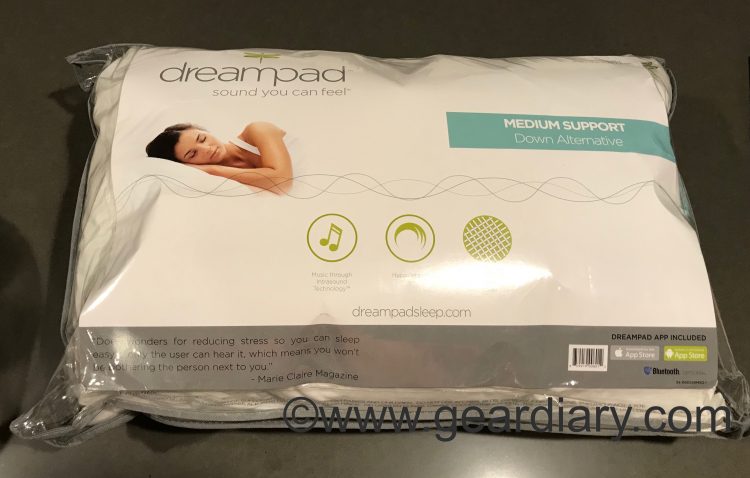The Dreampad pillow made an appearance on Shark Tank last night, but the “smart” pillow didn’t get a deal. Yes, the valuation of the deal was insane but, more than that, the Sharks didn’t understand that this isn’t a simple “pillow with a speaker inside. ” No, the Dreampad is something far more advanced. I have one and love it.

The Dreampad pillow comes in four versions. There is a Slim Support Pillow with an MSRP of $149; both the Medium and Firm Support Pillows have an MSRP of $159, and the Memory Support Pillow has an MSRP of $179. Even at the current discounts listed on the website, and a special “Buy Two for $119 each Shark Tank special”, that’s a rather insane price for “a pillow with a speaker inside.” The thing is, the Dreampad isn’t a “pillow with a speaker inside.” Instead, the Dreampad is a pillow whose “patented technology signals your internal relaxation response, helping your body and mind calm down and go to sleep.” The Dreampad makes use of bone conduction technology, so the sound travels from the pillow directly to the person whose head is placed in contact with it. Perhaps it’s best to let the company explain the technology.
The Dreampad operates on the natural principle of ‘bone conduction.’ We all hear ourselves speak in 2 ways – sound waves from our mouth travel through the air and enter our outer ear, and sound vibrations from our voice box travel internally by bone to our inner ear. (This is why your voice sounds different on a recording: you’re not hearing it with the vibrational resonance you get when you speak). The Dreampad transducers replicate that natural sound vibration. As the music travels to your inner ear, it triggers your body’s relaxation response, the parasympathetic nervous system. This results in a calming effect which is conducive to falling asleep and staying asleep.
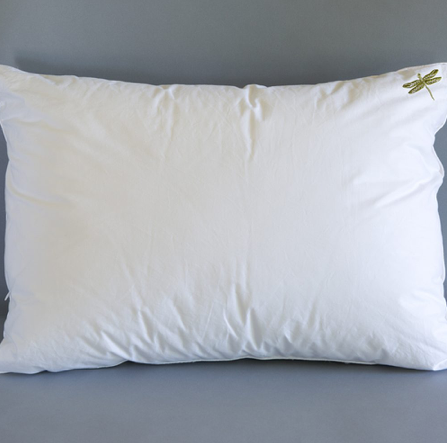
In other words, the vibration produced by the Dreampad travels internally to your ear and creates sound only the person using it can hear. This creates the claimed “calming effect” discussed by the creator without disturbing the person sleeping next to you. It is a lofty claim that is, believes it or not, completely true. I’ve been using the Dreampad review sample I was sent for the past week, and Raina didn’t even know it. In fact, yesterday she asked me why I haven’t been using the pillow and was surprised when I told her I’d used it every night since getting it.
One positive aspect of this is that you’re not disturbing others in the room when you’re using the Dreampad. More importantly, as the vibration moves toward the bony area surrounding your middle and inner ear, it is triggering your body’s relaxation response. Clinical data suggests that the calming effect of the Dreampad is a result of the vibrational music stimulating the vagus nerve, which in turn activates the parasympathetic nervous system (PNS). Our PNS helps us regulate stress – if we’re in a state of hyper-arousal, or elevated stress, the PNS is the part of our nervous system which brings us down to a calmer place where we can relax and fall asleep.
The Dreampad was first developed for children dealing with severe anxiety. It was initially intended as a relaxation tool to deal with issues such as trauma and autism, and it worked. In fact, “in many cases, a single child’s improved sleep had shifted the dynamic of the entire household.” But a funny thing happened. Parents began reporting that, while they were pleased with the impact the pillow had on their children, they had started borrowing the pillow to aid in their sleep. That eventually led to the release of the current four-pillow lineup of consumer products. As they explain:
Although the transition from pediatric therapy pad to the new Dreampad took a while, there are some benefits in having moved slowly. Most importantly, we can be confident that it is safe and that it works for most people. (Therapists report the Dreampad has helped about 80% of their clients.)
Now I know many of you are thinking something along the lines of, “This is voodoo science or the placebo effect at best.” Well, it’s not. Columbia University completed a peer-reviewed study in 2016 that showed the Dreampad’s effectiveness with stress-related sleep problems. There have also been studies conducted with war veterans with PTSD, children with ADHD, children with autism that compared the “Dreampad effect” to music through traditional speakers and all of them, have shown a statistical difference that favored the Dreampad. I’m no scientist but, having used the pillow for a week, I’m not surprised by any of this. It does make a difference for me. Here’s why…
The Dreampad operates on the natural principle of ‘bone conduction.’ We all hear ourselves speak in 2 ways – sound waves from our mouth travel through the air and enter our outer ear, and sound vibrations from our voice box travel internally by bone to our inner ear. (This is why your voice sounds different on a recording: you’re not hearing it with the vibrational resonance you get when you speak). The Dreampad transducers replicate that natural sound vibration. As the music travels to your inner ear, it triggers your body’s relaxation response, the parasympathetic nervous system. This results in a calming effect which is conducive to falling asleep and staying asleep.
The Dreampad system has two parts. There is the pillow itself and a control app that comes with 10 “music” choices. (Some are soothing sounds such as the ocean.)
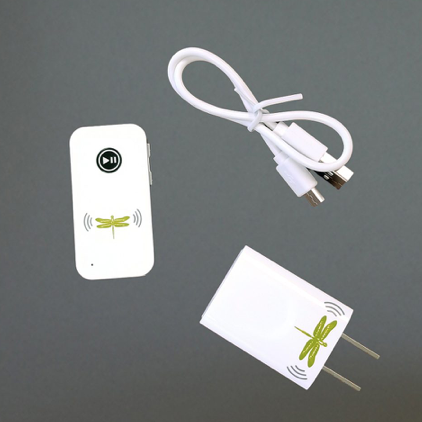
It also allows for Bluetooth connectivity, but to take advantage of that, you’ll need to purchase the Bluetooth adapter accessory for an additional cost. In the app’s preferences, you can set a sleep timer, adjust the volume and set an alarm.
The pillow has a cord that connects to the 3.5mm headphone jack on your audio source. Since my iPhone 7 doesn’t have such a port, I’m using an old iPod Touch as the source device. It’s actually a great way to repurpose an old phone or MP3 player. Everything is controlled from the app; the pillow itself has no battery or power source, as all of that comes from the source device.
In addition, if you don’t want to use the music or sounds built into the app, you can simply play your music and fall asleep that way. It apparently works just as well since it is the way the audio is delivered by the pillow itself rather than the actual music that triggers the relaxation response. I often fall asleep listening to music through headphones so as not to disturb Raina. The Dreampad is a far, far better solution in so many ways!
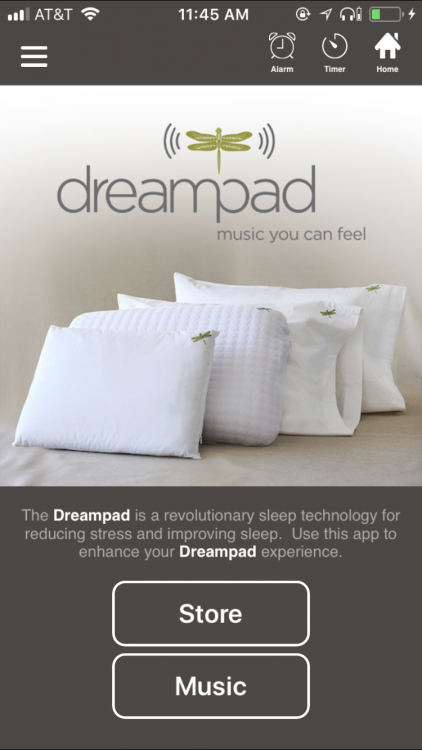
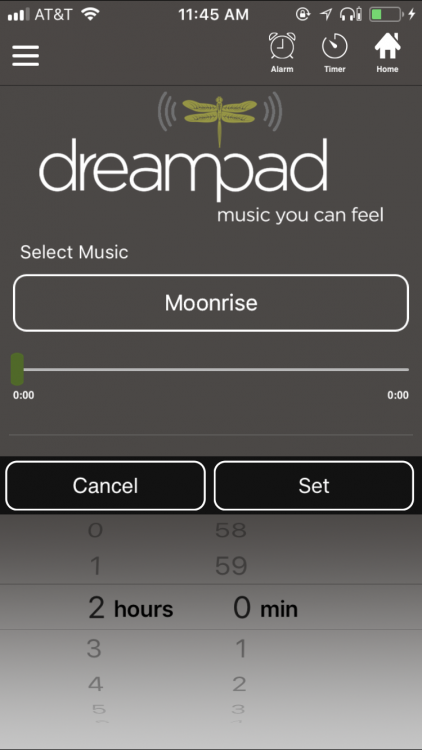
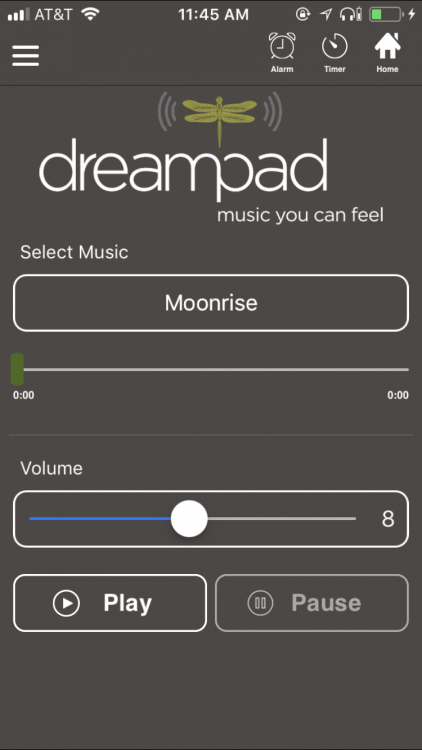
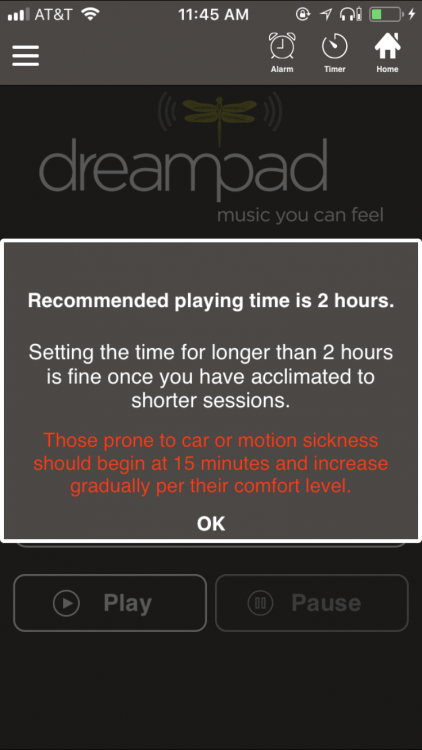
I was sent the Medium Support Pillow with Dreampad Technology for review. It is a 20” by 28” pillow with hypoallergenic polyfill and a 100% cotton shell. A zipper at one end opens to reveal the long cord for connecting to the audio source. There is also a smaller zippered mini-pocket that can be used to hold the Bluetooth adapter if you choose to go that route. I’m not interested in the Bluetooth approach since it would require me to remember to charge yet another device every few days. The pillow looks like any other pillow but has the company’s patented Intrasound Technology built into it. As a pillow, it is plenty comfortable on its own, but turning on the tech is what makes it stand out.
The app is available for both Android and iOS devices, and it comes with ten tracks that have been specifically engineered for deep sleep.
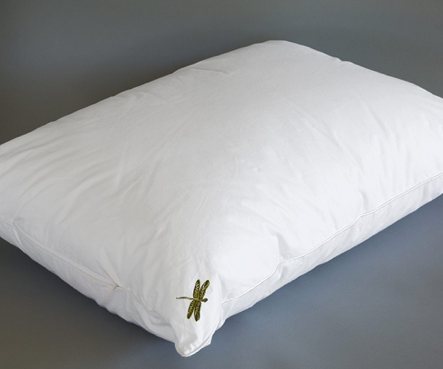
The product page includes this warning:
PUBLIC ADVISORY: FAMILY MEMBERS HAVE BEEN KNOWN TO STEAL DREAMPADS. YOU MIGHT WANT TO BUY A FEW.
They aren’t kidding. Raina tried my review sample and wanted to know why she doesn’t have one. I suggested that the company might want to make a version that is twice the size so a couple can share it and Raina enthusiastically agreed.
If you like to fall asleep to music but don’t want to bother your partner the Dreampad is for you.
If you have trouble falling and staying asleep, the Dreampad is for you.
If your mind races when you get into bed, the Dreamed is for you.
And if you don’t want to give up your review sample of the Dreampad, purchasing a second one is a must.
I’m a fan, and I wish they had gotten a deal with the Sharks last night. Check it out and order yours here.
Source: Manufacturer supplied review sample of the Dreampad
What I Like: Comfortable as a pillow; works… seriously, the Dreampad works
What Needs Improvement: Pricey; Doesn’t ship with the Bluetooth adapter; I wish they made a double sized that couples can use together
